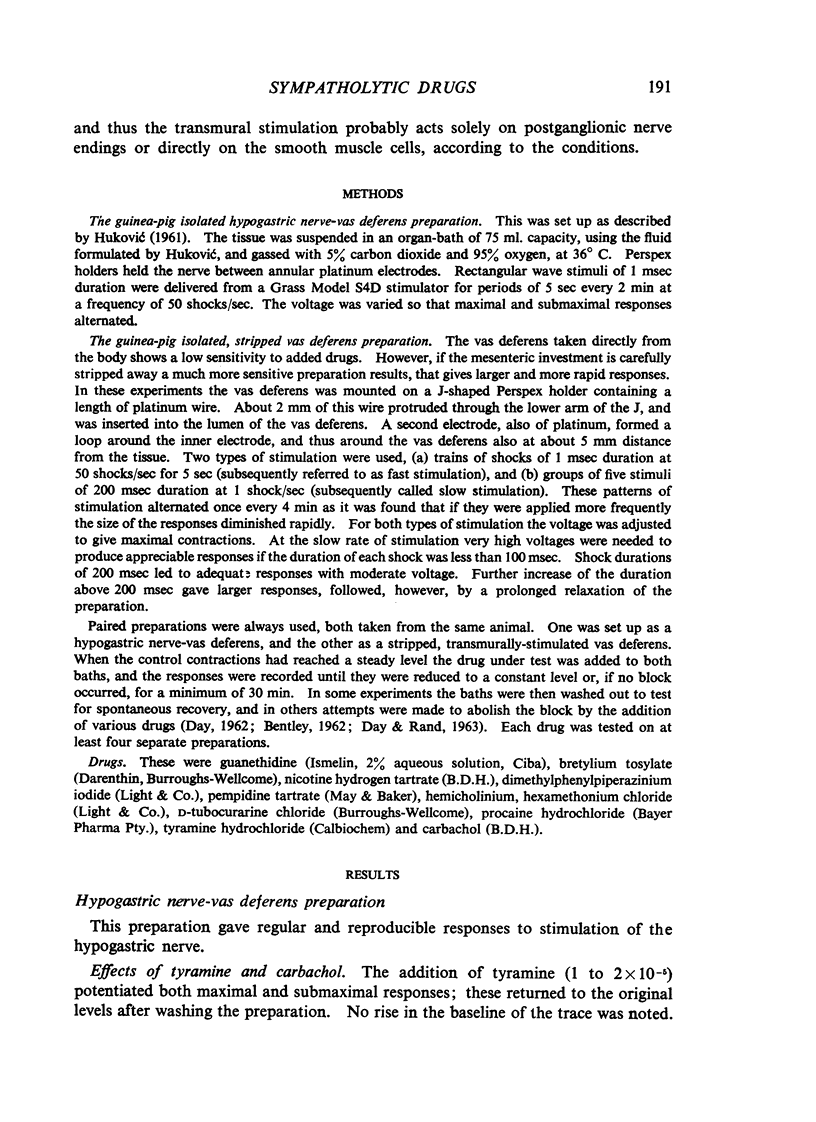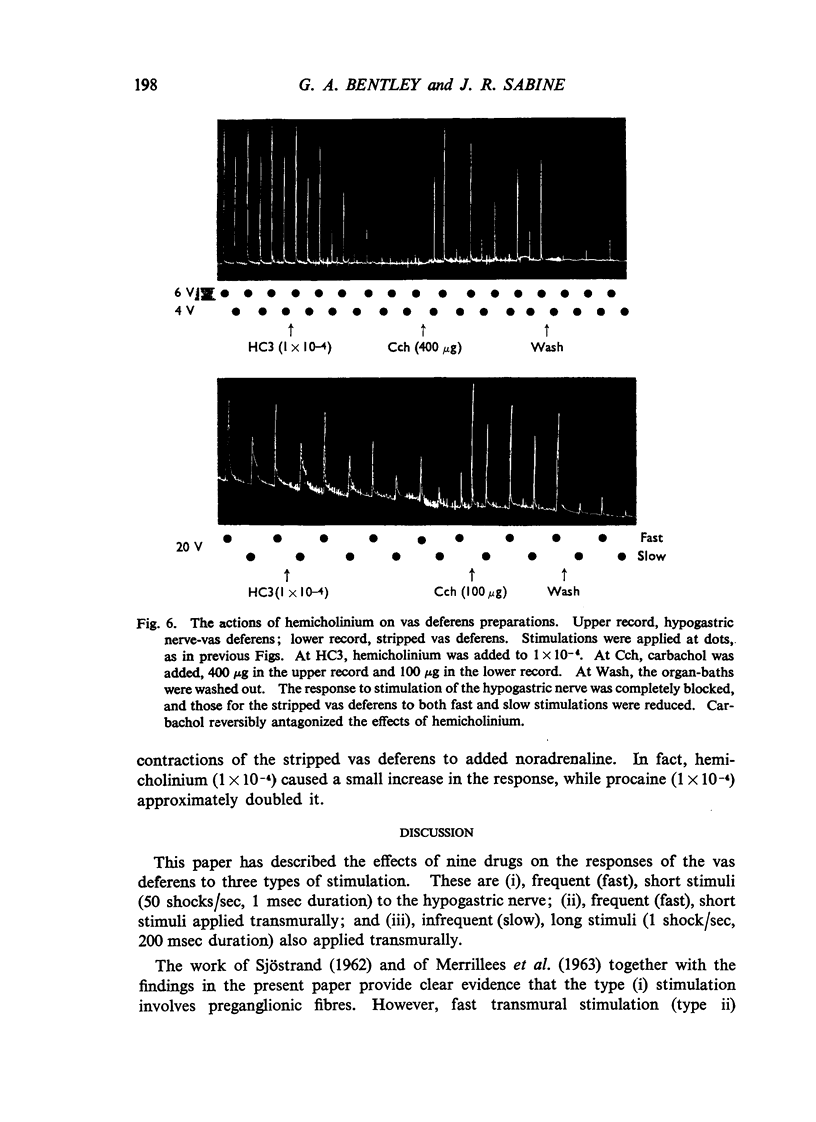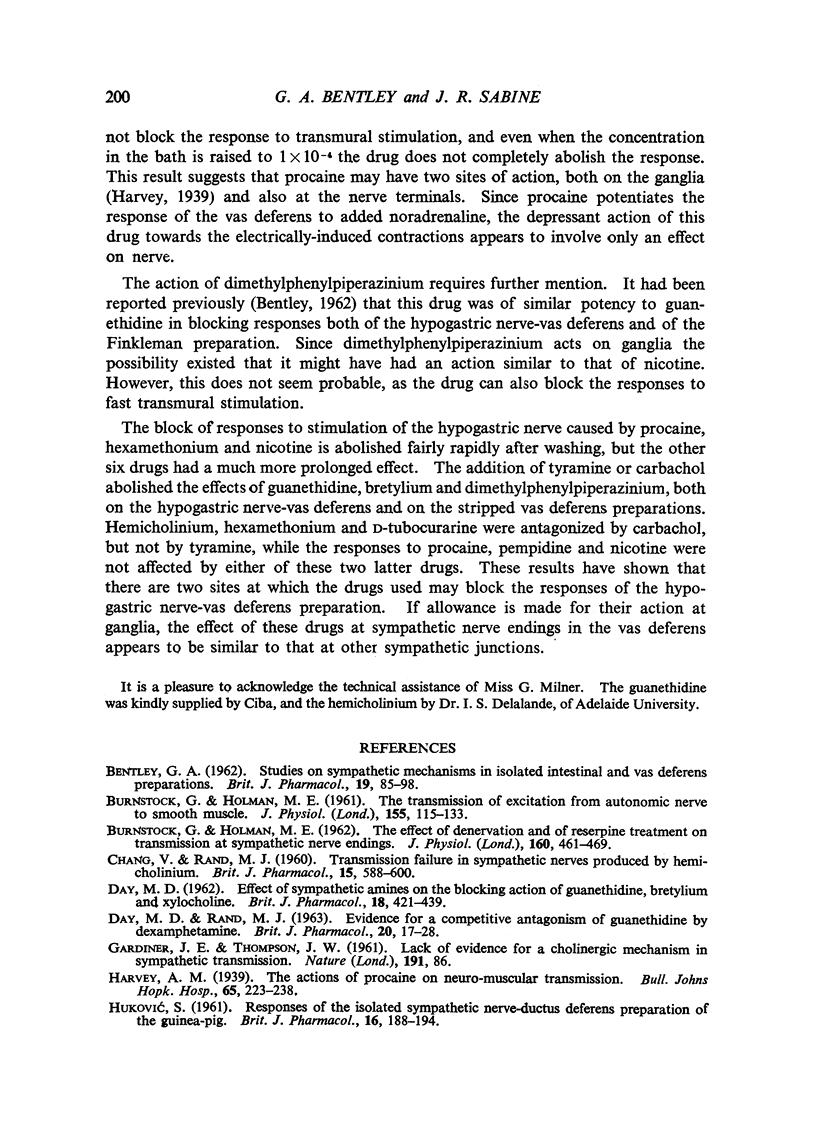Abstract
The contractions of the guinea-pig isolated vas deferens elicited by electrical stimulation of the hypogastric nerve were completely blocked by the following drugs: guanethidine, bretylium, dimethylphenylpiperazinium hydrochloride, nicotine, pempidine, hexamethonium, hemicholinium, D-tubocurarine and procaine. However, when the vas deferens was stimulated through an electrode in its lumen, the contractions in response to frequent, short stimuli (50 shocks/sec, 1 msec duration) were blocked by guanethidine, bretylium and dimethylphenylpiperazinium, but were not affected by the remaining drugs, except that procaine and hemicholinium each caused some reduction in the responses. When the preparation was stimulated transmurally with shocks of 200 msec duration at 1 shock/sec, the contractions were unaffected by any of the above drugs, except hemicholinium which again caused a slow reduction of up to 50% of the original response. It is concluded that nicotine, pempidine, hexamethonium, D-tubocurarine and hemicholinium probably block the response to stimulation of the hypogastric nerve by acting on peripheral ganglia in its pathway. Hemicholinium appears to have an additional effect in depressing the responses of the smooth muscle of the vas deferens to direct electrical stimulation, and procaine may act both on the ganglia and at the nerve terminals.
Full text
PDF











Selected References
These references are in PubMed. This may not be the complete list of references from this article.
- BENTLEY G. A. Studies on sympathetic mechanisms in isolated intestinal and vas deferens preparations. Br J Pharmacol Chemother. 1962 Aug;19:85–98. doi: 10.1111/j.1476-5381.1962.tb01429.x. [DOI] [PMC free article] [PubMed] [Google Scholar]
- BIRKS R. I., MACINTOSH F. C., SASTRY P. B. Pharmacological inhibition of acetylcholine synthesis. Nature. 1956 Nov 24;178(4543):1181–1181. doi: 10.1038/1781181a0. [DOI] [PubMed] [Google Scholar]
- BURNSTOCK G., HOLMAN M. E. Effect of denervation and of reserpine treatment on transmission at sympathetic nerve endings. J Physiol. 1962 Mar;160:461–469. doi: 10.1113/jphysiol.1962.sp006859. [DOI] [PMC free article] [PubMed] [Google Scholar]
- BURNSTOCK G., HOLMAN M. E. The transmission of excitation from autonomic nerve to smooth muscle. J Physiol. 1961 Jan;155:115–133. doi: 10.1113/jphysiol.1961.sp006617. [DOI] [PMC free article] [PubMed] [Google Scholar]
- CHANG V., RAND M. J. Transmission failure in sympathetic nerves produced by hemicholinium. Br J Pharmacol Chemother. 1960 Dec;15:588–600. doi: 10.1111/j.1476-5381.1960.tb00287.x. [DOI] [PMC free article] [PubMed] [Google Scholar]
- DAY M. D. Effect of sympathomimetic amines on the blocking action of guanethidine, bretylium and xylocholine. Br J Pharmacol Chemother. 1962 Apr;18:421–439. doi: 10.1111/j.1476-5381.1962.tb01421.x. [DOI] [PMC free article] [PubMed] [Google Scholar]
- DAY M. D., RAND M. J. Evidence for a competitive antagonism of guanethidine by dexamphetamine. Br J Pharmacol Chemother. 1963 Feb;20:17–28. doi: 10.1111/j.1476-5381.1963.tb01293.x. [DOI] [PMC free article] [PubMed] [Google Scholar]
- GARDINER J. E., THOMPSON J. W. Lack of evidence for a cholinergic mechanism in sympathetic transmission. Nature. 1961 Jul 1;191:86–86. doi: 10.1038/191086a0. [DOI] [PubMed] [Google Scholar]
- PATON W. D. The response of the guineapig ileum to electrical stimulation by coaxial electrodes. J Physiol. 1955 Feb 28;127(2):40–1P. [PubMed] [Google Scholar]
- RAND M. J., CHANG V. New evidence for a cholinergic process in sympathetic transmission. Nature. 1960 Dec 3;188:858–859. doi: 10.1038/188858a0. [DOI] [PubMed] [Google Scholar]


